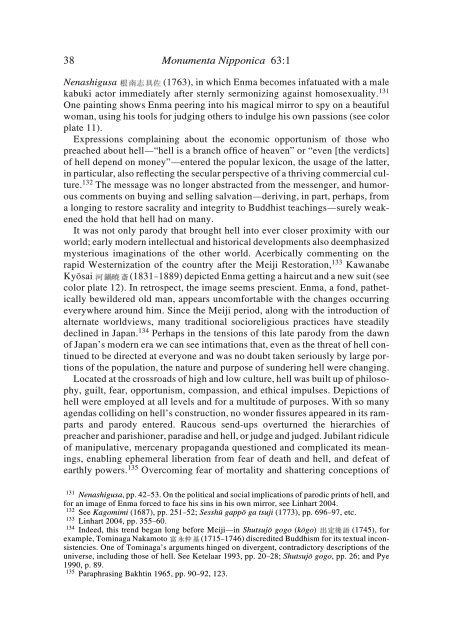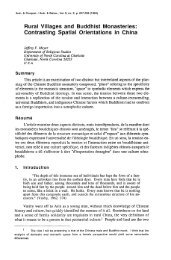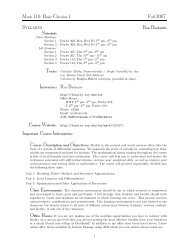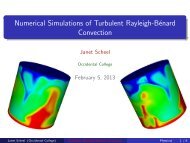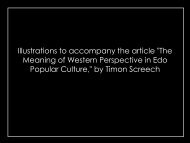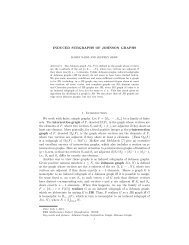A Primer on Japanese Hell Imagery and Imagination - Occidental ...
A Primer on Japanese Hell Imagery and Imagination - Occidental ...
A Primer on Japanese Hell Imagery and Imagination - Occidental ...
Create successful ePaper yourself
Turn your PDF publications into a flip-book with our unique Google optimized e-Paper software.
38<br />
M<strong>on</strong>umenta Nipp<strong>on</strong>ica 63:1<br />
Nenashigusa (1763), in which Enma becomes infatuated with a male<br />
kabuki actor immediately after sternly serm<strong>on</strong>izing against homosexuality. 131<br />
One painting shows Enma peering into his magical mirror to spy <strong>on</strong> a beautiful<br />
woman, using his tools for judging others to indulge his own passi<strong>on</strong>s (see color<br />
plate 11).<br />
Expressi<strong>on</strong>s complaining about the ec<strong>on</strong>omic opportunism of those who<br />
preached about hell—“hell is a branch office of heaven” or “even [the verdicts]<br />
of hell depend <strong>on</strong> m<strong>on</strong>ey”—entered the popular lexic<strong>on</strong>, the usage of the latter,<br />
in particular, also reflecting the secular perspective of a thriving commercial culture.<br />
132 The message was no l<strong>on</strong>ger abstracted from the messenger, <strong>and</strong> humorous<br />
comments <strong>on</strong> buying <strong>and</strong> selling salvati<strong>on</strong>—deriving, in part, perhaps, from<br />
a l<strong>on</strong>ging to restore sacrality <strong>and</strong> integrity to Buddhist teachings—surely weakened<br />
the hold that hell had <strong>on</strong> many.<br />
It was not <strong>on</strong>ly parody that brought hell into ever closer proximity with our<br />
world; early modern intellectual <strong>and</strong> historical developments also deemphasized<br />
mysterious imaginati<strong>on</strong>s of the other world. Acerbically commenting <strong>on</strong> the<br />
rapid Westernizati<strong>on</strong> of the country after the Meiji Restorati<strong>on</strong>, 133 Kawanabe<br />
Kyôsai (1831–1889) depicted Enma getting a haircut <strong>and</strong> a new suit (see<br />
color plate 12). In retrospect, the image seems prescient. Enma, a f<strong>on</strong>d, pathetically<br />
bewildered old man, appears uncomfortable with the changes occurring<br />
everywhere around him. Since the Meiji period, al<strong>on</strong>g with the introducti<strong>on</strong> of<br />
alternate worldviews, many traditi<strong>on</strong>al socioreligious practices have steadily<br />
declined in Japan. 134 Perhaps in the tensi<strong>on</strong>s of this late parody from the dawn<br />
of Japan’s modern era we can see intimati<strong>on</strong>s that, even as the threat of hell c<strong>on</strong>tinued<br />
to be directed at every<strong>on</strong>e <strong>and</strong> was no doubt taken seriously by large porti<strong>on</strong>s<br />
of the populati<strong>on</strong>, the nature <strong>and</strong> purpose of sundering hell were changing.<br />
Located at the crossroads of high <strong>and</strong> low culture, hell was built up of philosophy,<br />
guilt, fear, opportunism, compassi<strong>on</strong>, <strong>and</strong> ethical impulses. Depicti<strong>on</strong>s of<br />
hell were employed at all levels <strong>and</strong> for a multitude of purposes. With so many<br />
agendas colliding <strong>on</strong> hell’s c<strong>on</strong>structi<strong>on</strong>, no w<strong>on</strong>der fissures appeared in its ramparts<br />
<strong>and</strong> parody entered. Raucous send-ups overturned the hierarchies of<br />
preacher <strong>and</strong> parishi<strong>on</strong>er, paradise <strong>and</strong> hell, or judge <strong>and</strong> judged. Jubilant ridicule<br />
of manipulative, mercenary propag<strong>and</strong>a questi<strong>on</strong>ed <strong>and</strong> complicated its meanings,<br />
enabling ephemeral liberati<strong>on</strong> from fear of death <strong>and</strong> hell, <strong>and</strong> defeat of<br />
earthly powers. 135 Overcoming fear of mortality <strong>and</strong> shattering c<strong>on</strong>cepti<strong>on</strong>s of<br />
131 Nenashigusa, pp. 42–53. On the political <strong>and</strong> social implicati<strong>on</strong>s of parodic prints of hell, <strong>and</strong><br />
for an image of Enma forced to face his sins in his own mirror, see Linhart 2004.<br />
132 See Kagomimi (1687), pp. 251–52; Sesshû gappô ga tsuji (1773), pp. 696–97, etc.<br />
133 Linhart 2004, pp. 355–60.<br />
134 Indeed, this trend began l<strong>on</strong>g before Meiji—in Shutsujô gogo (kôgo) (1745), for<br />
example, Tominaga Nakamoto (1715–1746) discredited Buddhism for its textual inc<strong>on</strong>sistencies.<br />
One of Tominaga’s arguments hinged <strong>on</strong> divergent, c<strong>on</strong>tradictory descripti<strong>on</strong>s of the<br />
universe, including those of hell. See Ketelaar 1993, pp. 20–28; Shutsujô gogo, pp. 26; <strong>and</strong> Pye<br />
1990, p. 89.<br />
135 Paraphrasing Bakhtin 1965, pp. 90–92, 123.


